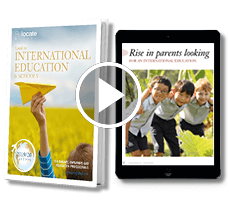Exploring curriculum options
Depending on their location, parents opting for an international school may have access to a range of curriculum options for their children. We look at the choices available for globally mobile families.
Curriculum: an important choice
Curriculum defines a school. People talk about IB World Schools, American or British international schools. The curriculum, in large part, sets international schools apart from each other, attracting staff as well as students, and defining, to some extent, the school ethos. For expatriate families who may be required to relocate every few years, the curriculum can be one of the few ways of providing a common thread for a child in an otherwise ever-changing school life. Globally mobile students benefit greatly from curriculum continuity when moving from one country to another, according to Mark London, head of marketing at ACS International Schools which teach both the American curriculum and IB.“Relocating families should look at the bigger picture and consider if another international move is likely in a few years’ time when choosing a curriculum,” he explains. “If so, following an internationally recognised education programme such as the IB is the sensible choice.”
Globally mobile students benefit greatly from curriculum continuity when moving from one country to another, according to Mark London, head of marketing at ACS International Schools which teach both the American curriculum and IB.“Relocating families should look at the bigger picture and consider if another international move is likely in a few years’ time when choosing a curriculum,” he explains. “If so, following an internationally recognised education programme such as the IB is the sensible choice.”Popular curriculum choices
The most common curriculum choices in international schools today are the National Curriculum of England, a US-oriented curriculum, and the International Baccalaureate (IB) programmes. Increasingly popular, too, are international curriculum options like the International Primary Curriculum and the International Middle Years Curriculum, which deliver the requirements of the National Curriculum of England in an internationally oriented way.The English national curriculum is the most popular curriculum choice in the world, followed by a US-oriented curriculum and the IB.The global accessibility of a curriculum can be a deciding factor for a relocating family when it comes to school selection. For example, although the Reggio Emilia learning approach – through which children seek knowledge through their own investigations – is highly valued by some, it is only available in a tiny percentage of English-medium international schools. If these schools are not located in areas the family may be moving to in the future, the Reggio Emilia approach may not be the best option for them.National curriculum of England
British expatriates often select an international school that follows the English National Curriculum. With so many British schools overseas, it is relatively easy to find a suitable school when moving from country to country.The British curriculum is the most successful and widely used in the world. One such school that follows it is Jerudong International School in Brunei Darussalam, which has children from 54 different countries. “Content is carefully chosen to ensure it is as relevant as possible to the students,” explains Nicholas Sheehan, principal.Following England’s National Curriculum is also considered by many students and parents of a range of nationalities, to be an effective route to university in the UK.“A levels are thought of as the gold standard qualification across the world and are still the main entry route for students to UK universities,” explains John Southworth, principal of MPW, an independent sixth form college group with schools in London, Birmingham and Cambridge. “A levels provide the essential depth of study required for entry into university especially for those students wanting to pursue career-based courses.”In 2018, 92 per cent of graduates from schools that are members of the the Council of British International Schools (COBIS) went on to study at university. Of those, 47 per cent went to university in the UK.Colin Bell, CEO of COBIS, says, “At any stage during the educational journey, the continuity of quality education is of significant importance, especially for mobile students and families who find themselves moving from one location to another.For those students who are working towards transitioning to the UK for a university place, the continuity of curriculum is paramount, and never more so than in the competitive global race for top university places.”Related article: US public school vs. private school education for the expat child
An American curriculum
Families relocating from the US are likely to choose an international school offering an American curriculum, or with an American orientation.The American School of The Hague (ASH) in Wassenaar, The Netherlands, is the area’s flagship school for a learnercentred, US-style education. Franne Van der Keilen, director of external relations at ASH, explains, “We offer an Americanstyle curriculum adapted to an international student body and have a dedicated Early Childhood Center for our youngest learners, aged three to six years. With options for a US High School Diploma, the International Baccalaureate and Advanced Placement, or a combination of these, coupled with strong Arts and Athletics programs, the opportunities for learning at ASH are deep and rich. As you tour our campus, you’ll explore the many learning opportunities unique to ASH - some in the classroom, some outside of it.”The International Baccalaureate (IB)
The IB caters for pupils aged from three to 19 and is taught in thousands of international schools in popular relocation destinations across the globe, including many independent and international schools and a small number of state schools in the UK and other countries.“The IB was founded in part to ensure that students of internationally mobile families could still work towards a shared, recognised qualification regardless of what city or country they found themselves in,” says a spokesperson for Shanghai Community International School, which caters for students from ages two to 18 across three campuses. “Since that time, the number of IB programmes around the world has dramatically increased. The IB continuum framework provides consistency wherever you are moving.”Cambridge Pathway
The Cambridge Assessment International Education provides another learning and curriculum pathway for international parents to move their family around the world by attending schools in their network of 10,000 schools in 160 countries. Cambridge Primary is for students aged five to 11 years, Cambridge Lower Secondary is typically for learners age 11 to 14, with Cambridge Upper Secondary for students preparing for Cambridge IGCSEs. Cambridge Advanced includes International AS and A Levels, and Pre-U.University of Cambridge International Examinations (CIE) examining board is the main awarding body of the IGCSE to overseas schools and UK independent schools.Like the AS and A Level, the CIE’s international qualification is aimed at students between the ages of 16 and 19. Cambridge AS and A Levels are taught in over 130 countries and thousands of CIE students have gone on to gain places at leading universities in countries around the world including the UK, Ireland, USA, Australia, New Zealand, Canada, China, India, Singapore, Egypt, South Africa, The Netherlands, Germany and Spain.This article is from Relocate Global's Guide to International Education & Schools 2019/20 which is packed with expert tips and information for those relocating and the professionals supporting them. For volume options, co-branded editions, digital or online licence agreements and advertising opportunities, contact Fiona Murchie at +44 (0)1892 891334 or email fiona@relocatemagazine.comNow available as an ebook on Amazon! Simply download from Amazon onto your Kindle, mobile phone or tablet to read wherever you are!
Subscribe to Relocate Extra, our monthly newsletter, to get all the latest international assignments and global mobility news.Relocate’s new Global Mobility Toolkit provides free information, practical advice and support for HR, global mobility managers and global teams operating overseas.
 Access hundreds of global services and suppliers in our Online Directory
Access hundreds of global services and suppliers in our Online Directory For more education and school-related news, visit our Education and Schools pages.© 2019. This article is an edited version of an article that appeared in the 2018/2019 edition of the Guide to International Education & Schools published by Relocate Global, Spray Hill, Hastings Road, Lamberhurst, Kent TN3 8JB. All rights reserved. This publication (or any part thereof) may not be reproduced in any form without the prior written permission of Relocate Global. Relocate Global accepts no liability for the accuracy of the contents or any opinions expressed herein.
For more education and school-related news, visit our Education and Schools pages.© 2019. This article is an edited version of an article that appeared in the 2018/2019 edition of the Guide to International Education & Schools published by Relocate Global, Spray Hill, Hastings Road, Lamberhurst, Kent TN3 8JB. All rights reserved. This publication (or any part thereof) may not be reproduced in any form without the prior written permission of Relocate Global. Relocate Global accepts no liability for the accuracy of the contents or any opinions expressed herein.©2025 Re:locate magazine, published by Profile Locations, Spray Hill, Hastings Road, Lamberhurst, Kent TN3 8JB. All rights reserved. This publication (or any part thereof) may not be reproduced in any form without the prior written permission of Profile Locations. Profile Locations accepts no liability for the accuracy of the contents or any opinions expressed herein.









































